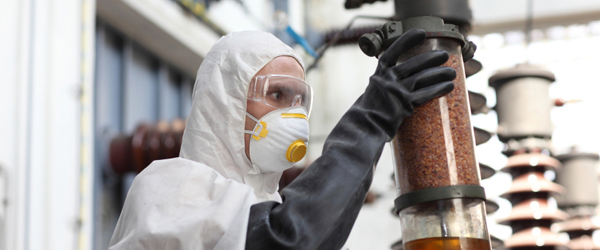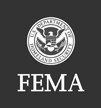Radiological Dispersion Device (RDD)
 Terrorist use of an RDD — often called “dirty nuke” or “dirty bomb” — is considered far more likely than use of a nuclear explosive device. An RDD combines a conventional explosive device — such as a bomb — with radioactive material. It is designed to scatter dangerous and sub-lethal amounts of radioactive material over a general area. Such RDDs appeal to terrorists because they require limited technical knowledge to build and deploy compared to a nuclear device. Also, the radioactive materials in RDDs are widely used in medicine, agriculture, industry and research, and are easier to obtain than weapons grade uranium or plutonium.
Terrorist use of an RDD — often called “dirty nuke” or “dirty bomb” — is considered far more likely than use of a nuclear explosive device. An RDD combines a conventional explosive device — such as a bomb — with radioactive material. It is designed to scatter dangerous and sub-lethal amounts of radioactive material over a general area. Such RDDs appeal to terrorists because they require limited technical knowledge to build and deploy compared to a nuclear device. Also, the radioactive materials in RDDs are widely used in medicine, agriculture, industry and research, and are easier to obtain than weapons grade uranium or plutonium.
The primary purpose of terrorist use of an RDD is to cause psychological fear and economic disruption. Some devices could cause fatalities from exposure to radioactive materials. Depending on the speed at which the area of the RDD detonation was evacuated or how successful people were at sheltering-in-place, the number of deaths and injuries from an RDD might not be substantially greater than from a conventional bomb explosion.
The size of the affected area and the level of destruction caused by an RDD would depend on the sophistication and size of the conventional bomb, the type of radioactive material used, the quality and quantity of the radioactive material, and the local meteorological conditions - primarily wind and precipitation. The area affected could be placed off-limits to the public for several months during cleanup efforts.
Before
 Before an Radiological Dispersion Device (RDD) Event
Before an Radiological Dispersion Device (RDD) Event
There is no way of knowing how much warning time there will be before an attack by terrorists using a Radiological Dispersion Device (RDD), so being prepared in advance and knowing what to do and when is important. To prepare for an RDD event, you should do the following:
- Build an Emergency Supply Kit, which includes items like non-perishable food, water, a battery-powered or hand-crank radio, extra flashlights and batteries. Also include:
- A roll of duct tape and scissors.
- During periods of heightened threat increase your disaster supplies to be adequate for up to two weeks.
- Make a Family Emergency Plan. Your family may not be together when disaster strikes, so it is important to know how you will contact one another, how you will get back together and what you will do in case of an emergency.
- Plan places where your family will meet, both within and outside of your immediate neighborhood.
- It may be easier to make a long-distance phone call than to call across town, so an out-of-town contact may be in a better position to communicate among separated family members.
- You may also want to inquire about emergency plans at places where your family spends time: work, daycare and school. If no plans exist, consider volunteering to help create one.
- Knowing your community's warning systems and disaster plans.
- Notify caregivers and babysitters about your plan.
- Make plans for your pets.
- Choose an internal room to shelter, preferably one without windows.
- Find out from officials if any public buildings in your community have been designated as fallout shelters. If none have been designated, make your own list of potential shelters near your home, workplace, and school. These places would include basements or the windowless center area of middle floors in high-rise buildings, as well as subways and tunnels.
- If you live in an apartment building or high-rise, talk to the manager about the safest place in the building for sheltering and about providing for building occupants until it is safe to go out.
Taking shelter during an RDD event is absolutely necessary. There are two kinds of shelters - blast and fallout. The following describes the two kinds of shelters:
- Blast shelters are specifically constructed to offer some protection against blast pressure, initial radiation, heat, and fire. But even a blast shelter cannot withstand a direct hit from a nuclear explosion.
- Fallout shelters do not need to be specially constructed for protecting against fallout. They can be any protected space, provided that the walls and roof are thick and dense enough to absorb the radiation given off by fallout particles.
During
During an Radiological Dispersion Device (RDD) Event
While the explosive blast will be immediately obvious, the presence of radiation will not be known until trained personnel with specialized equipment are on the scene. Whether you are indoors or outdoors, home or at work, be extra cautious. It would be safer to assume radiological contamination has occurred - particularly in an urban setting or near other likely terrorist targets - and take the proper precautions. As with any radiation, you want to avoid or limit exposure. This is particularly true of inhaling radioactive dust that results from the explosion. As you seek shelter from any location (indoors or outdoors) and there is visual dust or other contaminants in the air, breathe though the cloth of your shirt or coat to limit your exposure. If you manage to avoid breathing radioactive dust, your proximity to the radioactive particles may still result in some radiation exposure.
If the explosion or radiological release occurs inside, get out immediately and seek safe shelter. Otherwise, if you are:
| Outdoors | Indoors |
|---|---|
| Seek shelter indoors immediately in the nearest undamaged building.
If appropriate shelter is not available, cover your nose and mouth and move as rapidly as is safe upwind, away from the location of the explosive blast. Then, seek appropriate shelter as soon as possible. Listen for official instructions and follow directions. |
If you have time, turn off ventilation and heating systems, close windows, vents, fireplace dampers, exhaust fans, and clothes dryer vents. Retrieve your disaster supplies kit and a battery-powered radio and take them to your shelter room.
Seek shelter immediately, preferably underground or in an interior room of a building, placing as much distance and dense shielding as possible between you and the outdoors where the radioactive material may be. Seal windows and external doors that do not fit snugly with duct tape to reduce infiltration of radioactive particles. Plastic sheeting will not provide shielding from radioactivity nor from blast effects of a nearby explosion. Listen for official instructions and follow directions. |
After
After an Radiological Dispersion Device (RDD) Event
After finding safe shelter, those who may have been exposed to radioactive material should decontaminate themselves. To do this, remove and bag your clothing (and isolate the bag away from you and others), and shower thoroughly with soap and water. Seek medical attention after officials indicate it is safe to leave shelter.
Contamination from an RDD event could affect a wide area, depending on the amount of conventional explosives used, the quantity and type of radioactive material released, and meteorological conditions. Thus, radiation dissipation rates vary, but radiation from an RDD will likely take longer to dissipate due to a potentially larger localized concentration of radioactive material.
Follow these additional guidelines after an RDD event:
- Continue listening to your radio or watch the television for instructions from local officials, whether you have evacuated or sheltered-in-place.
- Do not return to or visit an RDD incident location for any reason.
More Information
Publications
If you require more information about any of these topics, the following resources may be helpful.
- Radiological Attack Fact Sheet: Dirty Bombs and Other Devices. Document providing preparation guidance for a chemical, biological, radiological, and nuclear threat.
Related Websites
Find additional information on how to plan and prepare for a RDD event and learn about available resources by visiting the following websites:
- Federal Emergency Management Agency
- American Red Cross
- Center for Disease Control and Prevention - Radiation Emergencies
- Environmental Protection Agency
Listen to Local Officials
Learn about the emergency plans that have been established in your area by your state and local government. In any emergency, always listen to the instructions given by local emergency management officials.


